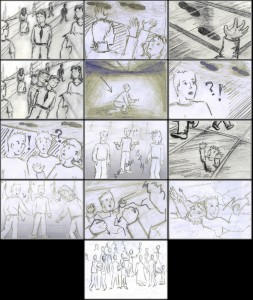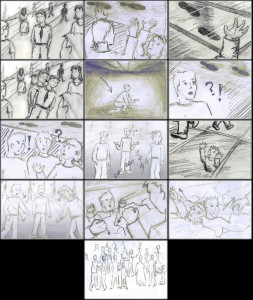Para leer este blog en español pincha aquí.
So now that we all know what we are doing, we need to know how to do it, and that can be a whole other kettle of fish.
Talking is easy, but putting it all together and making it work on the screen is completely different. We all understand what we’ve been talking about, but we’re interpreting the visual concept in a different way. If we want to work as a team we need to visualise the project, so we all know what we need and what is our aim. Some storyboarding would be useful…
Ok, so we need a lot of people (mental note: have an audition!), and we need a studio (start making phone calls), AND we need a big glass ceiling (Do we need a greenhouse?). This starts to look difficult, but we love challenges, don’t we?
The storyboard has been an important step forward for the project. We’ve realised how important the CGI (Computer Generated Images) will be and our meetings with the specialist in computer graphics have revolved around the storyboard. Meetings… this reminds me that evening in March when the director said: “Welcome to the night shift!” Long evenings in the office and early coffees in Camden around a table plenty of drafts… The best thing about this is that no one loses their optimism, there’s always someone able to put a smile in your face even when everything goes wrong.
Eventually, we’ve realised that we need to make some changes. How can something that we created to help us turn against us? We’ve been too obsessed with reproducing an accurate version of the storyboard, and that’s the problem. We can adapt the storyboard to our necessities, so let’s try to start with the creative thinking and redefine the shoots.
First of all, we still have some problems visualising the proposed video. We’re used to moving pictures, and a piece of paper doesn’t help too much.
Making this has helped us notice that we’re missing some really important stuff, the sound!
Now it’s time for some decision making. First of all our actors. But that’s a different problem…
If you want to get more information about the project “Speak out against discrimination”, click here.
For more information about Spectacle, click here.


